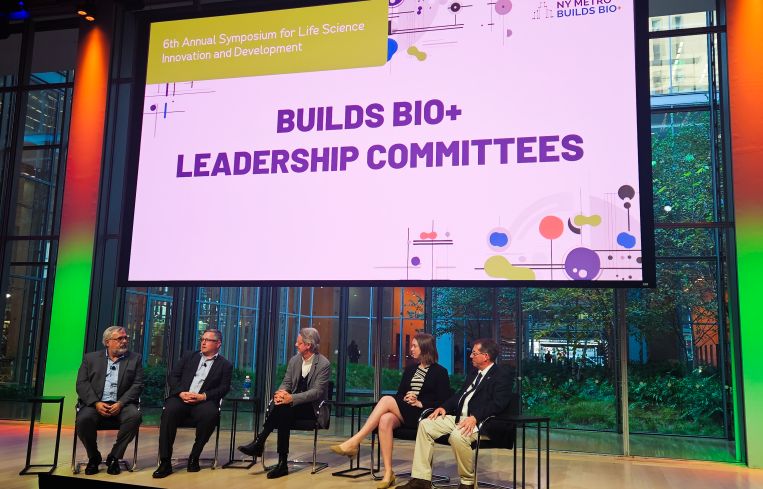New York Vies for Life Sciences Glory at Builds Bio+ Symposium
By Abigail Nehring November 3, 2023 6:00 am
reprints
Graduates from doctorate programs in life sciences might not dream of moving to New York to launch their careers, but the city wants to change that.
A group of young entrepreneurs, newly minted graduates, developers, and city and state officials gathered at the NY Metro Builds Bio+ symposium Wednesday with a shared goal: Making New York a global competitor in life sciences along with Boston, San Francisco, Baltimore and San Diego. And the recent slowdown in demand for life sciences space isn’t an impediment to their long-term plans.
“In the past, you had companies that formed here, maybe spun out from our local academic institutions, but they had to go elsewhere,” said Taconic Partners’ Matthew Weir during the day’s opening session.
To change that, talent recruitment, workforce training and real estate need to be part of New York City’s formula. “All these ingredients need to come together,” Weir said. “We were having these discussions six, seven years ago. Compared to then, we’ve taken major steps forward.”
And that’s clear with the groundswell of life science investment arriving in the city.
Taconic’s life sciences subsidiary, Elevate Research Properties, and Nuveen Real Estate have teamed up on a $600 million redevelopment of 125 West End Avenue, a full-block building on the Upper West Side offering commercial lab space with 54,000-square-foot floor plates.
Across town, Taconic has partnered DivcoWest and New York University for a research facility at 455 First Avenue in Kips Bay. The City University of New York’s Brookdale campus on the opposite side for First Avenue is being transformed simultaneously into a 1.5 million-square-foot Science Park and Research Center, known as SPARC Kips Bay. Mayor Eric Adams and the New York City Economic Development Corporation (EDC) kicked off the $1.6 billion project last year.
The city is “on the eve” of releasing its master plan for SPARC Kips Bay, said EDC’s Monica Malowney during a morning session. She teased a few of the details, noting the campus will include several City University of New York colleges, a public high school, an ambulatory center operated by NYC Health + Hospitals, and one or more “significant life sciences commercial towers.”
Academic researchers have been ebullient about the news, since it’s further evidence of the city’s desire to incubate startups, promote medical breakthroughs, and — they hope — persuade recent science grads to stay in New York City.
But panelists said SPARC Kips Bay isn’t the only life sciences development to get excited about in the city. Mount Sinai held the ribbon-cutting last month for the 150,000-square-foot Discovery and Innovation Center at 787 11th Avenue in Midtown West, and landlord The Georgetown Company plans to lease more floors of the 10-story industrial building to life sciences tenants.
Heading across the Harlem River, Simone Development is launching the next phase of development of the Hutchinson Metro Center, which will bring an additional 1.2 million square feet of office, medical, and research space to Morris Park in the Bronx.
In one of the day’s lightning rounds, Rockefeller University’s Carlo Yuvienco spoke about the new Ford Center for Life Science Innovation, which was completed this summer on Rockefeller’s Upper East Side campus and will accommodate 15 to 20 startups.
“This is fairly new for Rockefeller,” Yuvienco said. “It will be highly bespoke.”
New York has also caught the attention of Meta CEO Mark Zuckerberg and his wife, Priscilla Chan, who recently committed $250 million over 10 years for a 25,000-square-foot biohub in Manhattan led by researchers from Columbia University, Rockefeller, and Yale.
“They should add a zero to that, and it would really be good,” said session moderator Michael De Chiara of law firm Zetlin & De Chiara.
The city and state have each committed $10 million to the project — one of many overtures government officials have made to lure life science companies to New York.
“What New York City is doing is investing in the real estate, so that a life sciences company could come here, and the risk isn’t as great,” Loretta Beine, director of industry development for New York Empire State Development, said during another session. “Years ago, every dime came out of the company to build out that space. The risk has been reduced.”
Abigail Nehring can be reached at anehring@commercialobserver.com.


